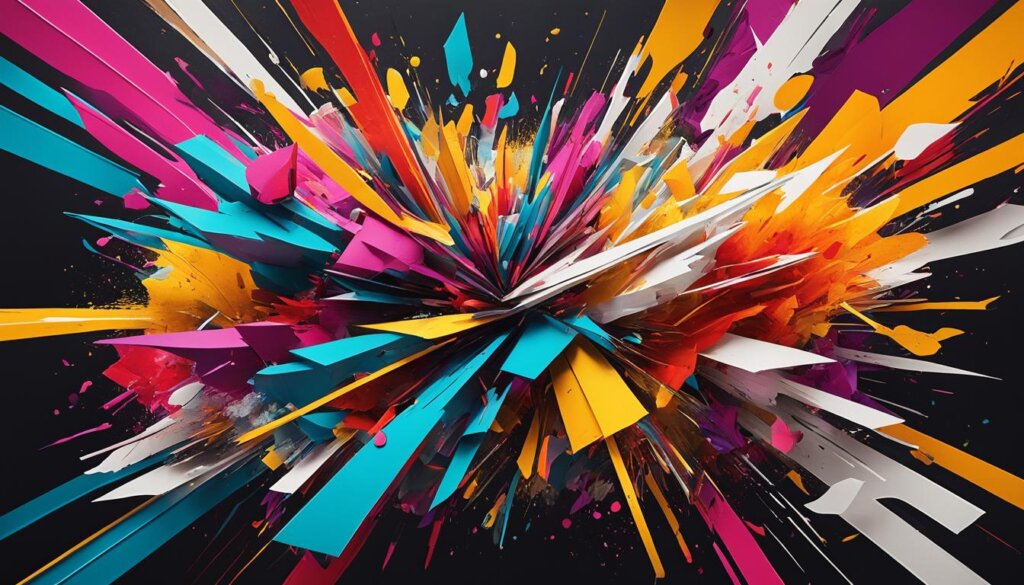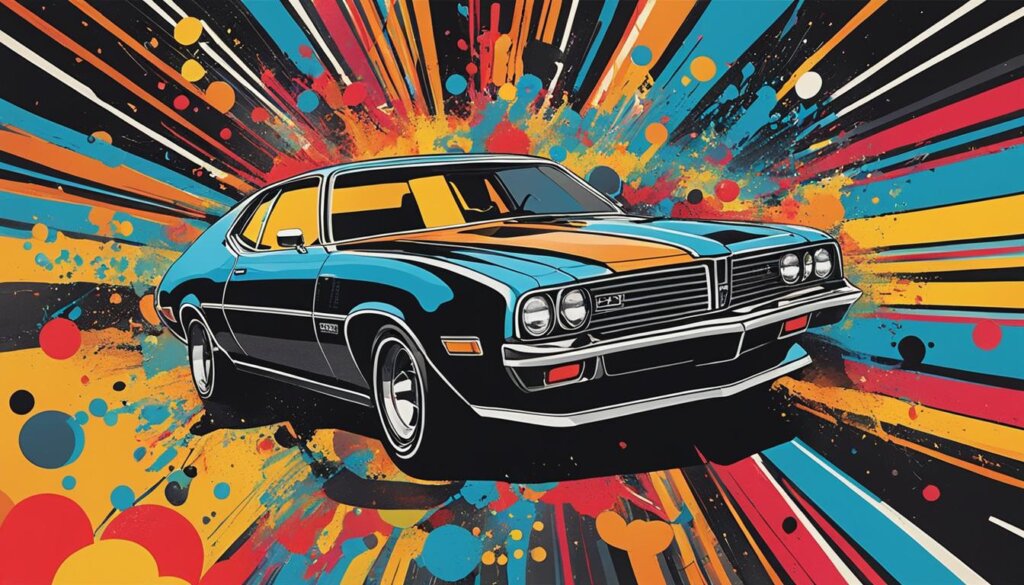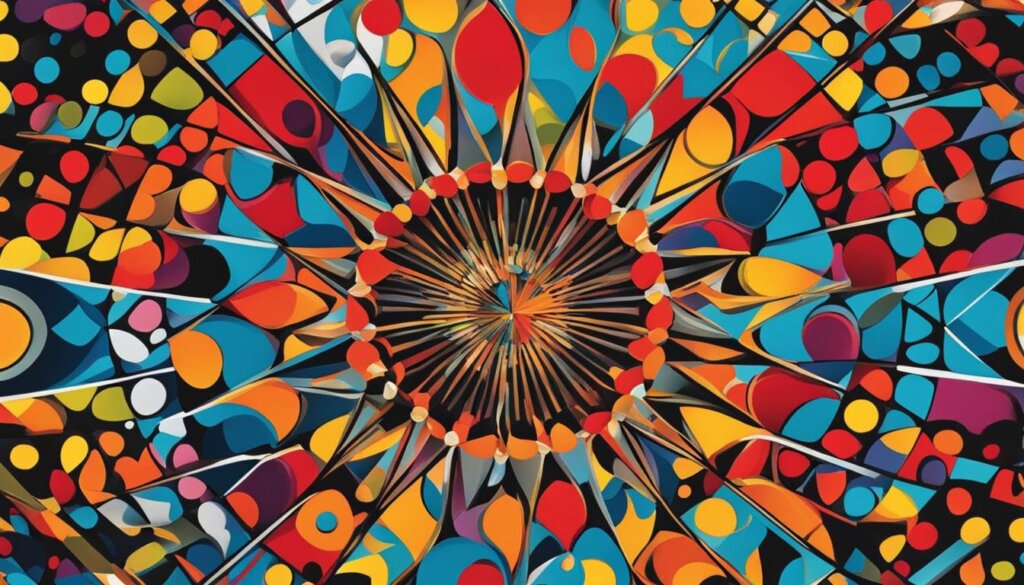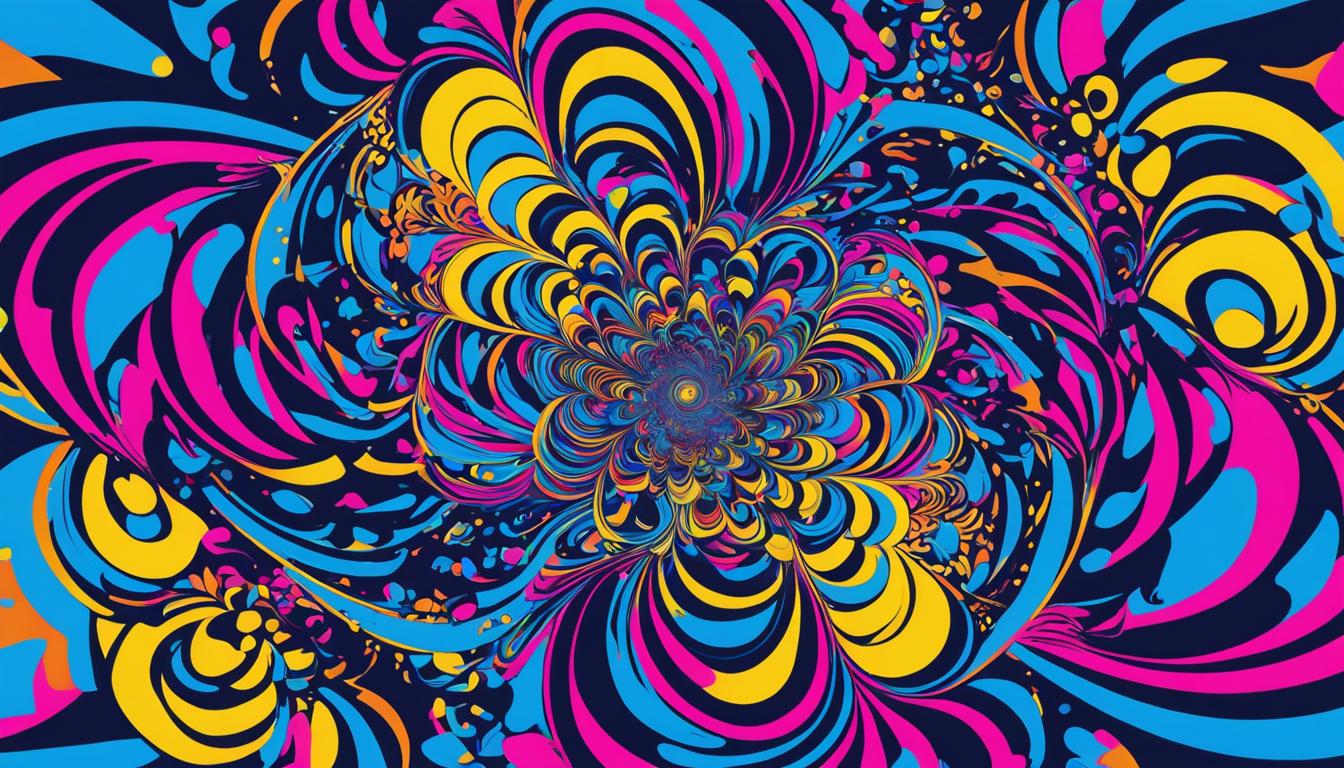Welcome to our journey into the captivating realm of 70s art! In this article, we will delve into the vintage, retro, and abstract art movements that defined this era. Join us as we explore the fascinating world of pop art, psychedelic art, modern art, and contemporary art, unraveling their significance in art history.
The 1970s witnessed a creative revolution that challenged traditional norms and redefined the boundaries of art. Influenced by the social events and cultural movements of the late 1960s, 70s artists embarked on a quest to push the limits of artistic expression. From thought-provoking abstract concepts to captivating visual experiences, this vibrant era left an indelible mark on the art world.
Land Art, Feminist Art, Gutai Art, Performance Art, and Abstract Art were just some of the groundbreaking movements that emerged during this time. These artistic styles expanded the definition of art and invited viewers to engage with art in new and exciting ways. From showcasing the integration of art with nature to challenging gender norms and advocating for social change, these art movements captivated audiences and ignited important conversations.
Throughout this journey, we will also explore the influential artists who played a pivotal role in shaping the 70s art scene. From the thought-provoking assemblages of Betye Saar to the trailblazing feminist art of Judy Chicago, we will delve into their unique perspectives and creative contributions.
Join us as we uncover the profound influence of 70s art on contemporary art practices. The experimental and boundary-pushing nature of this era continues to inspire artists today, as they push the boundaries of artistic expression and explore new ideas. The themes and concepts of identity, gender, and social justice explored in the 70s remain as relevant as ever in today’s contemporary art landscape.
The Challenges That Influenced the 1970s Art Style
The 1970s art style, characterized by its vibrant and eclectic nature, was deeply influenced by the challenges and transformations of its time. The social events of the late 1960s, such as the rise of the hippie culture and widespread student demonstrations, ignited a revolutionary spirit among artists, leading to a departure from traditional notions of art.
Artists of the 1970s sought to explore unconventional topics and embrace new perspectives. They dared to venture into uncharted territory, delving into themes related to the body, ecology, art documentation, and transitory concepts. By pushing the boundaries of traditional art, these artists opened up new avenues for creativity and self-expression.
One of the most influential movements during this era was the feminist art movement. It challenged existing power structures and advocated for a shift in subject matter, giving voice to women artists and exploring the complexities of gender and identity. The feminist art movement paved the way for a more inclusive and diverse art landscape.

The challenges of the 1970s propelled artists to confront societal norms and question the established order. They embraced the spirit of rebellion and experimentation, seeking to redefine what art could be. This era witnessed the birth of new art forms and movements that continue to inspire and influence contemporary artists.
The Most Important 1970s Art Styles
The 1970s marked the emergence of several influential art styles that left a lasting impact on the art world. These diverse movements opened up new avenues of expression and challenged conventional artistic norms. Let’s explore some of the most significant art styles that defined the 1970s.
Land Art
Also known as Earth Art, Land Art sought to connect art with the natural environment. Artists created large-scale installations and sculptures in outdoor settings, often utilizing natural materials like rocks, earth, and plants. Land Art aimed to create a harmonious relationship between art and nature, challenging the traditional confines of galleries and museums. This artistic movement encouraged viewers to explore and appreciate the beauty of natural landscapes.
Feminist Art
Feminist Art emerged as a powerful force in the 1970s, challenging patriarchal norms and advocating for gender equality. Women artists reclaimed their voices, addressing themes of identity, sexuality, and the female experience. They brought attention to the underrepresentation of women in the art world and defied traditional art forms. Feminist Art sparked important conversations and paved the way for a more inclusive and equitable art space.
Gutai Art
Originating in Japan, Gutai Art emphasized the artist’s physical presence and spontaneity in the creative process. Artists explored new techniques and materials, often incorporating performance elements and interactive installations. Gutai Art celebrated the human connection to art, pushing boundaries and encouraging viewer engagement. It embodied the belief that art is a constantly evolving experience.
Performance Art
Performance Art transcended traditional artistic mediums by incorporating live actions and audience participation. Artists used their bodies as the primary tool for expression, blurring the line between art and life. Performance Art challenged societal norms, addressing political and social issues in a provocative and unique way. This art form aimed to create an intimate and interactive experience, leaving a lasting impact on both the artist and the viewer.
Abstract Art
Although Abstract Art had its peak in the early 20th century, it continued to influence the art scene of the 1970s. Abstract Art aimed to express emotions and ideas through non-representational forms and colors. Artists experimented with various techniques and visual elements to create compositions that evoked a range of emotions and interpretations. Despite experiencing a decline in popularity, Abstract Art still remained a significant part of the 1970s art landscape.

These art styles – Land Art, Feminist Art, Gutai Art, Performance Art, and Abstract Art – defined the diversity and experimentation of the 1970s art scene. Each movement challenged traditional notions and expanded the boundaries of artistic expression. Their influence continues to resonate in contemporary art, inspiring new generations of artists to push the limits of creativity.
Important 1970s Artists
In the vibrant world of 70s Art, several artists left an indelible mark on the art scene, pushing boundaries and challenging conventions. Let’s explore some of the important artists who shaped the art world during this era.
Betye Saar
Betye Saar is a renowned artist known for her compelling assemblages that challenge racial and gender stereotypes. Through her thought-provoking artworks, Saar explores themes of identity, history, and social justice.
Judy Chicago
Judy Chicago is a feminist artist who played a pivotal role in shedding light on women’s history and representation in art. Her iconic artwork, “The Dinner Party,” is a powerful testament to the accomplishments and contributions of women throughout history.
Chuck Close
Chuck Close achieved fame for his meticulous grid technique, which he used to create photorealistic portraits. His artistic approach captivated audiences and brought a fresh perspective to the representation of the human form.
Lynda Benglis
Lynda Benglis is known for her provocative and boundary-pushing artworks that explore themes of gender and sexuality. Her controversial Artforum ad, featuring her posing with a suggestive gesture, sparked conversations about the objectification of women in the art world.
Barbara Kruger
Barbara Kruger’s text-based artworks made a powerful impact by challenging consumerism, gender norms, and power dynamics. Her bold statements, often presented in black and white, were thought-provoking and demanded attention.
These artists, among many others, helped shape the dynamic and diverse art scene of the 1970s. Their unique perspectives and innovative approaches continue to influence and inspire contemporary artists to this day.

The Influence of 1970s Art
The 1970s art movement left an indelible mark on the art world, shaping contemporary art practices to this day. The experimental and boundary-pushing nature of the art styles and artists of the 70s challenged traditional norms, allowing for the emergence of new artistic expressions.
Themes surrounding identity, gender, and social justice, which were explored in depth during the 1970s, continue to resonate in contemporary art. The legacy of 70s art can be observed in the works of today’s artists, who strive to push boundaries and explore novel ideas.
Contemporary art owes much of its diversity and freedom to the influence of 70s art. The impact of this era’s artists and their trailblazing techniques can be seen in the rich tapestry of contemporary art practices, demonstrating the enduring relevance of 70s art in shaping the artistic landscape of today.

